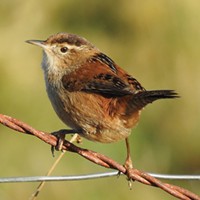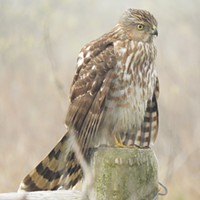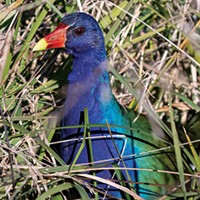[
{
"name": "Top Stories Video Pair",
"insertPoint": "7",
"component": "17087298",
"parentWrapperClass": "fdn-ads-inline-content-block",
"requiredCountToDisplay": "1"
}
]
Earlier this year, I celebrated a major birthday — well, "survived" is perhaps the better word. It was one of those milestones that falls on the far side of middle-aged, where it's a lot harder to convince yourself the crackling sounds you hear when you heave yourself out of your cushy recliner are coming from your furniture and not your facet joints. As the anniversary of my birth drew near, I was excited, true, but also resigned, maybe even a little grumpy. So, what did I do? Go birding, of course.
And not just any birding: I consulted with local avian expert and guide Rob Fowler and we agreed I needed a life bird — one I'd never seen and identified before — to mark the occasion. After weighing a few candidates, the one we settled on was the marbled murrelet, a small bird facing some big challenges — and with a secret life that makes it unique.
The marbled murrelet is an alcid, a family of seabirds that includes puffins, auklets and murres. But while the other alcids nest on cliffs or rocky coastal islands, the marbled murrelet nests in trees, laying a single egg on the moss-covered limb of an old growth redwood or Douglas fir. The male and female take turns incubating the egg and commuting up to 30 miles to the ocean to provide fish for their speckled chick. Their breeding plumage of brown "marbled" with white is the perfect camouflage for their forest-canopy nest.
Though listed as endangered in California since 1992, these robin-sized birds continue to reside in moderate numbers here on the coast, and there are a few places to find them reliably. Yet somehow, in two decades of Humboldt birding, I hadn't managed to find even one. I was murrelet-challenged.
When the big day arrived, Fowler and I met up with three fellow birders and hit the road north. Though the morning had started off shrouded in fog, the farther we traveled, the more blue sky we found, with sunlight falling in dazzling columns through the redwood canopy. Gaps in the trees framed heart-stopping views of the Pacific that stretched to infinity. I'd seen it all before but suddenly everything about the place I lived seemed exciting and new.
Our first stop was just north of Freshwater Lagoon. We scanned the ocean with scopes and binoculars for marbled murrelets, which are black and white in winter and often swim in pairs well out from shore. The wind was cold and tall swells capped in white foam crashed onto the beach. A Clark's grebe surfed the waves — a good bird but not the one we were looking for. The same was true of a flock of black scoters, striking sea ducks with coal-black plumage and orange knobs on their bills. We tried two other locations at various points south with no luck.
After a few murrelet-less hours, we ended up at a pullout on Scenic Drive. Our vantage point high up on the bluff gave us a panoramic view of calmer waters. Not far offshore was a rocky islet covered in common murres, hundreds of them circling the rock like a cloud of insects. While the rest of us were ooh-ing and ahh-ing over the masses of murres, Fowler scanned the ocean and suddenly announced, "Marbled murrelets in the scope!" And there they were: two tiny black and white birds swimming through the surf.
We picked up a few more great birds before heading to Vista Point in McKinleyville for a tailgate party with cake, ice cream and more incredible views. It was an unforgettable birthday.
In the weeks since, though, this unusual and mysterious bird has often been in my thoughts. Despite its protected status, the marbled murrelet's numbers have continued to decline at an alarming rate. The once-huge tracts of old growth forest that offered a safe haven for its sky-high nests have been cut relentlessly; what's left are fractured groves mostly found in state and national parks, leaving the murrelet vulnerable to the kind of predators that follow humans and their trash into the parks. The specter of extinction is a harrowing possibility.
Amid the overwhelming crises that continue to stagger our world, the plight of a tiny seabird seems almost insignificant. It's just one bird, after all. Most people have never even heard of it.
But it matters. Every bird matters. And if we can pull together and find a way to save this bird, then maybe we have what it takes to fix those other problems, big and small.
I'm told during breeding season the marbled murrelets leave their nests at dawn and fly to the Pacific Ocean, their keer calls piercing the early morning stillness. My dream is that when my next milestone rolls around, I'll celebrate it by listening to those calls echo through tall trees at first light, in greater numbers than ever before. And that we, as stewards of this planet, will continue to do what's necessary to ensure this tiny bird always finds a place to make its nest 150 feet up in the sky, and that inaction and indifference are replaced by something more sustainable: hope.
And that there'll be more cake.
Sarah Hobart (she/her) is a freelance writer based in Humboldt County.
Speaking of...
-

A Chime of Wrens
Apr 11, 2024 -

Bird Names for Everyone
Feb 29, 2024 -

Spark Birds
Jan 11, 2024 - More »
more from the author
-
A Chime of Wrens
- Apr 11, 2024
-
Bird Names for Everyone
- Feb 29, 2024
-
Spark Birds
- Jan 11, 2024
- More »
Latest in Get Out
Readers also liked…
-
A Walk Among the Spotted Owls
- Apr 27, 2023
































